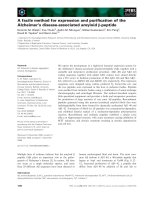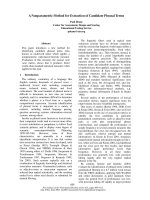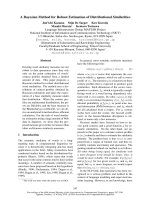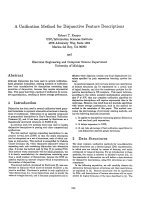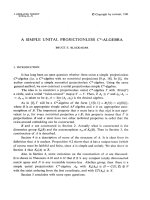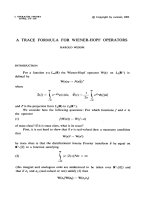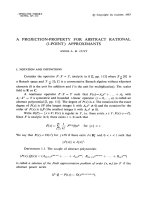Báo cáo toán học: "A Simple Method for Constructing Small Cubic Graphs of Girths 14, 15, and 16" pptx
Bạn đang xem bản rút gọn của tài liệu. Xem và tải ngay bản đầy đủ của tài liệu tại đây (74.08 KB, 3 trang )
A Simple Method for Constructing Small Cubic Graphs of Girths
14, 15, and 16
Geoffrey Exoo
Department of Mathematics and Computer Science
Indiana State University
Terre Haute, IN 47809
Submitted: September 20, 1996; Accepted: September 26, 1996
Abstract
A method for constructing cubic graphs with girths in the range 13 to 16 is described. The
method is used to construct the smallest known cubic graphs for girths 14, 15 and 16.
Introduction
We consider the problem of finding smallest regular graphs with given girth and degree: the
cage
problem. This problem has a prominent place in both Extremal and Algebraic Graph Theory.
Biggs book on Algebraic Graph Theory [1] provides an introduction to this subject. Wong’s survey
article [3] gives a comprehensive picture of the state of the art in 1982. In this note, we shall be
specifically interested in cubic (trivalent) cages and note that the current status of the problem can
be obtained from Gordon Royle [2].
The General Construction
We describe a family of cubic graphs with girths in the stated range. We begin with a description
of a type of generalized Petersen graph that does not quite achieve our girth objectives, and then
consider adjustments to the construction that will increase the girth.
Let
T
be a
cubic tree
(a tree in which each vertex has degree 1 or 3) on
t
vertices. Then
t
is
even and
r
=
t/
2 + 1 is the number of endvertices. Let
T
1
, ,T
n
be
n
copies of
T
. Suppose the
1
the electronic journal of combinatorics 3 (1996), #R30 2
vertices of T
i
are labeled v
i,0
, ,v
i,t−1
so that vertices v
i,0
v
i,r−1
are the endvertices. Initially
we require that the mapping from T
i
to T
j
given by v
i,k
→ v
j,k
be an isomorphism, for all i and
j. In this case we can obtain a simple generalization of the Petersen graph by choosing r positive
integers h
1
h
r
, h
i
<n/2, and joining vertex v
i,k
to v
i+h
i
,k
. This gives a trivalent graph. It will
be convenient to call the edges in one of the T
i
’s tree edges and the edges joining two of the trees
chords. Note that for the Petersen graph we have n =5,T = K
2
, h
1
=1,andh
2
=2.
Any tree with degree set {1, 3} has two endvertices at distance 2. Therefore the graphs described
in the previous paragraph have girth at most 12, since we can find a 12-cycle consisting of four
pairs of tree edges (each pair joining two endvertices at distance 2) and four chords. Specifically, let
v
i,x
and v
i,y
be endvertices adjacent to v
i,z
in T
i
. Then the following vertices determine a 12-cycle:
v
i,x
, v
i,z
, v
i,y
, v
i+h
y
,y
, v
i+h
y
,z
, v
i+h
y
,x
, v
i+h
y
+h
x
,x
, v
i+h
y
+h
x
,z
, v
i+h
y
+h
x
,y
, v
i+h
x
,y
, v
i+h
x
,z
,andv
i+h
x
,x
(addition of subscripts in modulo n).
To achieve larger girth, we make a modification to the construction. First we drop the require-
ment that the mapping v
i,k
→ v
j,k
be an isomorphism for all i and j and instead require that it
be an isomorphism when i − j is even. When i − j is odd, we require only that it be a bijection
that maps endvertices to endvertices. Note that parity considerations become important here, so
we must have n even.
A Cubic Graph of Girth 14
For example, let T be the cubic tree on 6 vertices. For even i, we label it so that it’s five edges
are:
(v
i,0
,v
i,4
), (v
i,1
,v
i,4
), (v
i,2
,v
i,5
), (v
i,3
,v
i,5
), and (v
i,4
,v
i,5
).
For odd i, we label so that the edges are:
(v
i,0
,v
i,4
), (v
i,3
,v
i,4
), (v
i,1
,v
i,5
), (v
i,2
,v
i,5
), and (v
i,4
,v
i,5
).
Also, we let: h
0
=1,h
1
= 22, h
2
=9,andh
3
= 34. and finally, n = 82. This gives us a trivalent
graph on 492 vertices. It can be checked by computer that this graph has girth 14, and is the
smallest known such graph [2].
A Cubic Graph of Girth 15
For our girth 15 construction we use a tree on 14 vertices which we label so that the edge list
is as follows:
(v
i,0
,v
i,8
), (v
i,1
,v
i,8
), (v
i,2
,v
i,9
), (v
i,3
,v
i,9
), (v
i,4
,v
i,10
), (v
i,5
,v
i,10
), (v
i,6
,v
i,11
), (v
i,7
,v
i,11
),
(v
i,8
,v
i,12
), (v
i,9
,v
i,12
), (v
i,10
,v
i,13
), (v
i,11
,v
i,13
), and (v
i,12
,v
i,13
).
the electronic journal of combinatorics 3 (1996), #R30 3
For odd i,welabelT
i
so that it’s edges are:
(v
i,0
,v
i,8
), (v
i,6
,v
i,8
), (v
i,2
,v
i,9
), (v
i,4
,v
i,9
), (v
i,1
,v
i,10
), (v
i,5
,v
i,10
), (v
i,3
,v
i,11
), (v
i,7
,v
i,11
),
(v
i,8
,v
i,12
), (v
i,9
,v
i,12
), (v
i,10
,v
i,13
), (v
i,11
,v
i,13
), and (v
i,12
,v
i,13
).
And we let h
0
=1,h
1
= 11, h
2
=9,h
3
=19,h
4
=7,h
5
= 37, h
6
= 17, and h
7
= 13. If we also
let n = 80, we have a trivalent graph of order 1120 having girth 15, once again the smallest such
graph known [2].
A Cubic Graph of Girth 16
For girth 16 we take n = 140 and use the complete binary tree with radius two. For even i we
label T
i
so that its edges are:
(v
i,0
,v
i,6
), (v
i,1
,v
i,6
), (v
i,2
,v
i,7
), (v
i,3
,v
i,7
), (v
i,4
,v
i,8
), (v
i,5
,v
i,8
), (v
i,6
,v
i,9
), (v
i,7
,v
i,9
), and
(v
i,8
,v
i,9
).
Whereas for odd i ourlabelinggivestheedges:
(v
i,1
,v
i,6
), (v
i,2
,v
i,6
), (v
i,3
,v
i,7
), (v
i,4
,v
i,7
), (v
i,5
,v
i,8
), (v
i,0
,v
i,8
), (v
i,6
,v
i,9
), (v
i,7
,v
i,9
), and
(v
i,8
,v
i,9
).
Also we let h
0
=1,h
1
=9,h
2
= 23, h
3
=57,h
4
= 67, and h
5
= 43., thereby producing a trivalent
graph of order 1400 with girth 16, the smallest such graph yet discovered [2].
AFinalNote
For a given n and t, it is fairly easy to do an exhaustive search through all graphs of this type
discussed above. So we were able to verify that these are the smallest such graphs with the stated
girth values. In addition, other similar families were considered. We relaxed the requirement that
T be a tree, and also considered cubic forests. And we tried replacing the single values of h
i
by sets
of values (we tried sets of size two). Neither of these modifications produced better constructions.
References
[1] N.L. Biggs, Algebraic Graph Theory (2nd ed.), Cambridge University Press, 1993.
[2] G. Royle, Cubic Cages, />September, 1996 (Accessed: September 20, 1996).
[3] P.K. Wong. Cages - a survey, JournalofGraphTheory,6, 1982, 1-22.
